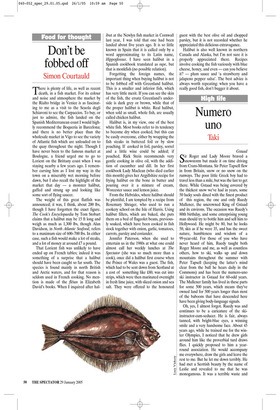Don’t be fobbed off
Simon Courtauld
There is plenty of life, as well as recent death, in a fish market. For its colour and noise and atmosphere the market by the Rialto bridge in Venice is as fascinating to me as a visit to the Scuola degli Schiavoni to see the Carpaccios. To buy, or just to admire, the fish landed on the Spanish Mediterranean coast I would highly recommend the Boqueria in Barcelona; and there is no better place than the wholesale market in Vigo to see the variety of Atlantic fish which are unloaded on to the quay throughout the night. Though I have never been to the famous market at Boulogne, a friend urged me to go to Lorient on the Brittany coast when I was staying nearby a few years ago. I remember cursing him as I lost my way in the town on a miserably wet morning before dawn, but I also recall the highlight of the market that day — a monster halibut, gaffed and strung up and looking like some sort of flying saucer.
The weight of this great flatfish was announced; it was, I think, about 200 lbs, though I have forgotten the exact figure. The Cook’s Encyclopaedia by Tom Stobart claims that a halibut may be 15 ft long and weigh as much as 1,300 lbs, though Alan Davidson, in North Atlantic Seafood, refers to a maximum size of 600–700 lbs. In either case, such a fish would make a lot of steaks, and a lot of money at around £7 a pound.
That Lorient fish was unlikely to have ended up on French tables; indeed it was something of a surprise that a halibut should have been caught so far south. The species is found mainly in north British and Arctic waters, and for that reason is seldom used in French cooking. No mention is made of the flétan in Elizabeth David’s books. When I inquired after hal ibut at the Newlyn fish market in Cornwall last year, I was told that one had been landed about five years ago. It is so little known in Spain that it is called only by a word approximating to its Latin name, Hippoglossus. I have seen halibut in a Spanish cookbook translated as rape, but that is monkfish (no possible relation).
Forgetting the foreign names, the important thing when buying halibut is not to be fobbed off with Greenland halibut. This is a smaller and inferior fish, which has very little merit. If you can see the skin of the fish, the ersatz Greenland’s underside is dark grey or brown, while that of the proper halibut is white. Real halibut, when sold as small, whole fish, are usually called chicken halibut.
Halibut is, in my view, one of the best white fish. Most books refer to its tendency to become dry when cooked, but this can be easily overcome, either by wrapping the fish steaks in buttered foil or by slow poaching. If cooked in foil, parsley, sorrel and a little wine could be added; if poached, Rick Stein recommends very gentle cooking in olive oil, with the addition of cucumber and dill. In her first cookbook Lady Maclean (who died earlier this month) gives her Argyllshire recipe for frying halibut on the bone in butter and pouring over it a mixture of cream, Worcester sauce and lemon juice.
From the Hebrides, where halibut should be plentiful, I am tempted by a recipe from Rosemary Shrager, who used to run a cookery school on the Isle of Harris. Using halibut fillets, which are baked, she puts them on a bed of flageolet beans, previously soaked, which have been cooked in fish stock together with onion, garlic, tomatoes, carrots, parsley and coriander.
Jennifer Paterson, when she used to entertain us in the 1980s at what one could almost call her weekly lunches at The Spectator (she was so much more than a cook), once did a halibut first course when the Prince of Wales was a guest. The fish, which had to be sent down from Scotland at a cost of something like £80, was cut into strips, which were then marinated overnight in fresh lime juice, with sliced onion and sea salt. They were offered to the honoured guest with the best olive oil and chopped parsley, but it is not recorded whether he appreciated this delicious extravagance.
Halibut is also well known in northern Canada and Alaska, but I’m not sure it is properly appreciated there. Recipes involve cooking the fish variously with blue cheese, honey, and even — can you believe it? — plum sauce and ‘a strawberry and jalapeno pepper salsa’. The best advice is always worth repeating: when you have a really good fish, don’t bugger it about.















































 Previous page
Previous page